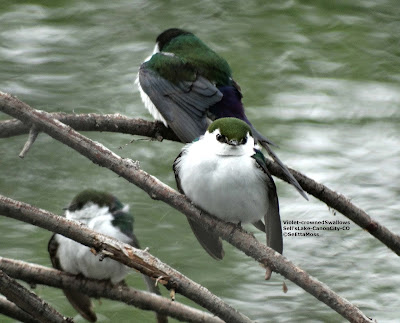Shorebird survives flight through Hurricane Irene!
]
While birds and other wildlife have evolved over thousands of years with hurricanes and other severe weather events, they are still subject to their impacts. In a blog entry titled "Seven Things to Know About How Hurricanes Affect Wildlife" by Kevin Coyle on the National Wildlife Federation 'Wildlife Promise' blog site, a story is recounted about a Brown Pelican (like the bird above that I photographed this past January) that was reported in the news media as having been blown very far off course to Nova Scotia during Hurricane Earl.
Mr. Coyle goes on to discuss how perching birds cling with their toes wrapped around branches, an adaptation that keeps them safely perched in trees while they sleep also. Various other species of birds have evolved different strategies to help them cope with hurricanes. Other species are also affected and this blog notes that "some dolphins and manatees have actually been blown ashore during major storms."
[created by Steve Maslowski/USFWS"] I just read one amazing story about a migrating shorebird, called a Whimbrel, that flew through the most dangerous part of Hurricane Irene this week as it flew in migration towards it's wintering grounds in South America. This little bird named Chinquapin, only about a foot and a half in length, is part of a tracking program by the Center for Conservation Biology and their partners in which tiny radio transmitters are attached to ride on the bird's back and send signals that show important information on it's route and progress as it migrates. The radio signals indicate that the Whimbrel apparently made it safely through the hurricane and that it was able to land on an island in the Bahamas on Friday. Additional signals Saturday confirms it appears safe on the ground on this island. The director of The College of William & Mary's Center for Conservation Biology, Bryan Watts, was quoted in an article on this in USA Today as saying, "When he was in the outer bands of the storm he was flying at 30 miles per hour." Mr. Watts was duly impressed, and so am I!
I just read one amazing story about a migrating shorebird, called a Whimbrel, that flew through the most dangerous part of Hurricane Irene this week as it flew in migration towards it's wintering grounds in South America. This little bird named Chinquapin, only about a foot and a half in length, is part of a tracking program by the Center for Conservation Biology and their partners in which tiny radio transmitters are attached to ride on the bird's back and send signals that show important information on it's route and progress as it migrates. The radio signals indicate that the Whimbrel apparently made it safely through the hurricane and that it was able to land on an island in the Bahamas on Friday. Additional signals Saturday confirms it appears safe on the ground on this island. The director of The College of William & Mary's Center for Conservation Biology, Bryan Watts, was quoted in an article on this in USA Today as saying, "When he was in the outer bands of the storm he was flying at 30 miles per hour." Mr. Watts was duly impressed, and so am I!
I don't know about you, but I am terribly impressed by this little shorebird's amazing flight through this hurricane. Did you know that Whimbrels can fly up to 3,200 miles non-stop? SeEtta (originally posted to Birds and Blooms magazine online blog @http://birdsandbloomsblog.com/2011/08/28/shorebird-survives-flight-through-hurricane-irene/
While birds and other wildlife have evolved over thousands of years with hurricanes and other severe weather events, they are still subject to their impacts. In a blog entry titled "Seven Things to Know About How Hurricanes Affect Wildlife" by Kevin Coyle on the National Wildlife Federation 'Wildlife Promise' blog site, a story is recounted about a Brown Pelican (like the bird above that I photographed this past January) that was reported in the news media as having been blown very far off course to Nova Scotia during Hurricane Earl.
Mr. Coyle goes on to discuss how perching birds cling with their toes wrapped around branches, an adaptation that keeps them safely perched in trees while they sleep also. Various other species of birds have evolved different strategies to help them cope with hurricanes. Other species are also affected and this blog notes that "some dolphins and manatees have actually been blown ashore during major storms."
[created by Steve Maslowski/USFWS"]
I don't know about you, but I am terribly impressed by this little shorebird's amazing flight through this hurricane. Did you know that Whimbrels can fly up to 3,200 miles non-stop? SeEtta (originally posted to Birds and Blooms magazine online blog @http://birdsandbloomsblog.com/2011/08/28/shorebird-survives-flight-through-hurricane-irene/


Comments